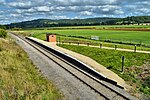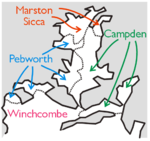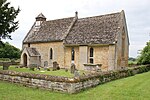Toddington railway station
Former Great Western Railway stationsHeritage railway stations in GloucestershirePages with no open date in Infobox stationRailway stations in Great Britain closed in 1960Railway stations in Great Britain opened in 1904 ... and 3 more
Railway stations in Great Britain opened in 1984Stanway, GloucestershireUse British English from September 2017

Toddington railway station serves the village of Toddington in Gloucestershire, England. Since 1984 it has been the main base of operations for the heritage Gloucestershire Warwickshire Railway. The station is located on the Honeybourne Line which linked Cheltenham and Stratford-upon-Avon and which was opened by the Great Western Railway in 1906. The station was a centre of fruit and milk traffic, but receipts dwindled after a railwaymen's strike in 1955. The station closed to passengers in 1960, although the line itself remained open for freight and diversionary use until 1976; the track was lifted in 1979-80.
Excerpt from the Wikipedia article Toddington railway station (License: CC BY-SA 3.0, Authors, Images).Toddington railway station
B4077, Tewkesbury Toddington
Geographical coordinates (GPS) Address External links Nearby Places Show on map
Geographical coordinates (GPS)
| Latitude | Longitude |
|---|---|
| N 51.9891 ° | E -1.92813 ° |
Address
Toddington
B4077
GL54 5DT Tewkesbury, Toddington
England, United Kingdom
Open on Google Maps










